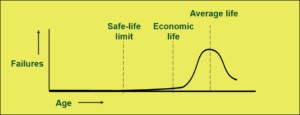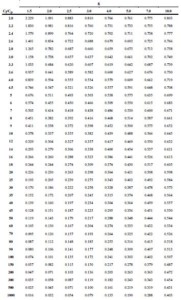How to Select The Optimum Fixed Time Maintenance Intervals
 Think about your maintenance program. How often are your PMs scheduled? How were those frequencies established? If you are in the majority, the chances are that the frequencies were either established from the OEM manual, or by someone in the department without data.
Think about your maintenance program. How often are your PMs scheduled? How were those frequencies established? If you are in the majority, the chances are that the frequencies were either established from the OEM manual, or by someone in the department without data.
Establishing the correct frequency of maintenance activities is critical to the success of any maintenance program. Too infrequently and the organization is subjected to failures, resulting in poor operational performance. Too frequently, and the organization is subjected to excess planned downtime and an increased probability of maintenance induced failures. So how do you establish the correct maintenance frequencies for your organization? There are three different approached to use, based on the type of maintenance being performed;
- Time-Based Maintenance
- On-Condition Maintenance
- Failure Finding Maintenance
This article will focus on Time Based Maintenance Tasks.
Time-Based Maintenance Tasks
“The frequency of a scheduled task is governed by the age at which the item of or component shows a rapid increase in the conditional probability of failure” (RCM2). When establishing frequencies for Time Based Maintenance, it is required that the life be identified for the component based on data.
With time-based failures, a safe life and useful life exists. The safe life is when no failures occur before that date or time. Unless the failure consequence is environmental, or safety related, the safe life would not normally be used. The useful life (economic life limit), is when the cost of consequences of a failure starts to exceed the cost of the time-based maintenance activity. There is a trade-off at this point between the potential lost production and the cost of planned downtime, labour, and materials.
So how is the safe life or useful life established? It is established using failure data and history. This history can be reviewed using a Weibull Analysis, Mean Cumulative Failure Analysis or even a Crow-AMSAA Analysis to statistically determine the life of the component. Once that life is determined using a statistical analysis, the optimum cost effective frequency must be established.
Establishing the Optimum Economic Frequency
 This formula is used to establish the economic life of the component, balancing the cost of the downtime vs. the cost of the replacement.
This formula is used to establish the economic life of the component, balancing the cost of the downtime vs. the cost of the replacement.
Where;
- CT= The total cost per unit of time
- Cf= The cost of a failure
- CP= The cost of the PM
- T = The time between PM activities
The formula will provide the total cost based on the maintenance frequency. Since the calculation can be time-consuming, Dodson developed a table which can be used if;
- The time to fail follows a Weibull Distribution
- PM is performed on an item at time T, at the cost of CP
- If the item fails before time = T, a failure cost of Cf is incurred
- Each time a PM is performed, the item is returned to its initial state “as good as new”
Therefore when using the table, use formula; T=mѲ+δ. Where;
- m is a function of the ratio of the failure cost to PM cost and the value of the shape
- Ѳ is the scale parameter of the Weibull distribution
- δ is the location parameter of the Weibull distribution
In the example below, you can see how the table can be used with the formula;
The cost for a PM activity $60. The cost of a failure for the same item is $1800. Given the Weibull parameter of B=3.0, O=120 days, and δ =3 how often should the PM be performed?
- Cf/ CP = x
- 1800/60 = 30
The table value of m given a shape parameter B of 3.0 is 0.258. Therefore;
- T=mѲ+δ
- T = (0.258)(120)+3 = 33.96
- T = 34 days for each PM
As you can see, determining the frequency of Fixed Time Maintenance tasks is not as simple as picking a number out of a manual or based on intuition. Armed with this information, a cost effective PM frequency based on data can be developed for your Fixed Time Maintenance tasks. This will ensure the right maintenance is done at the right time, driving your plant performance further.
Does you Fixed Time Maintenance Tasks have this level of rigor behind them? Why, not? After all, your plant performance (operational and financial) depends on it. Stay tuned for next week’s post on establishing frequencies for On-Condition tasks.
Remember, to find success; you must first solve the problem, then achieve the implementation of the solution, and finally sustain winning results.
I’m James Kovacevic
Eruditio, LLC
Where Education Meets Application
Follow @EruditioLLC
References;

